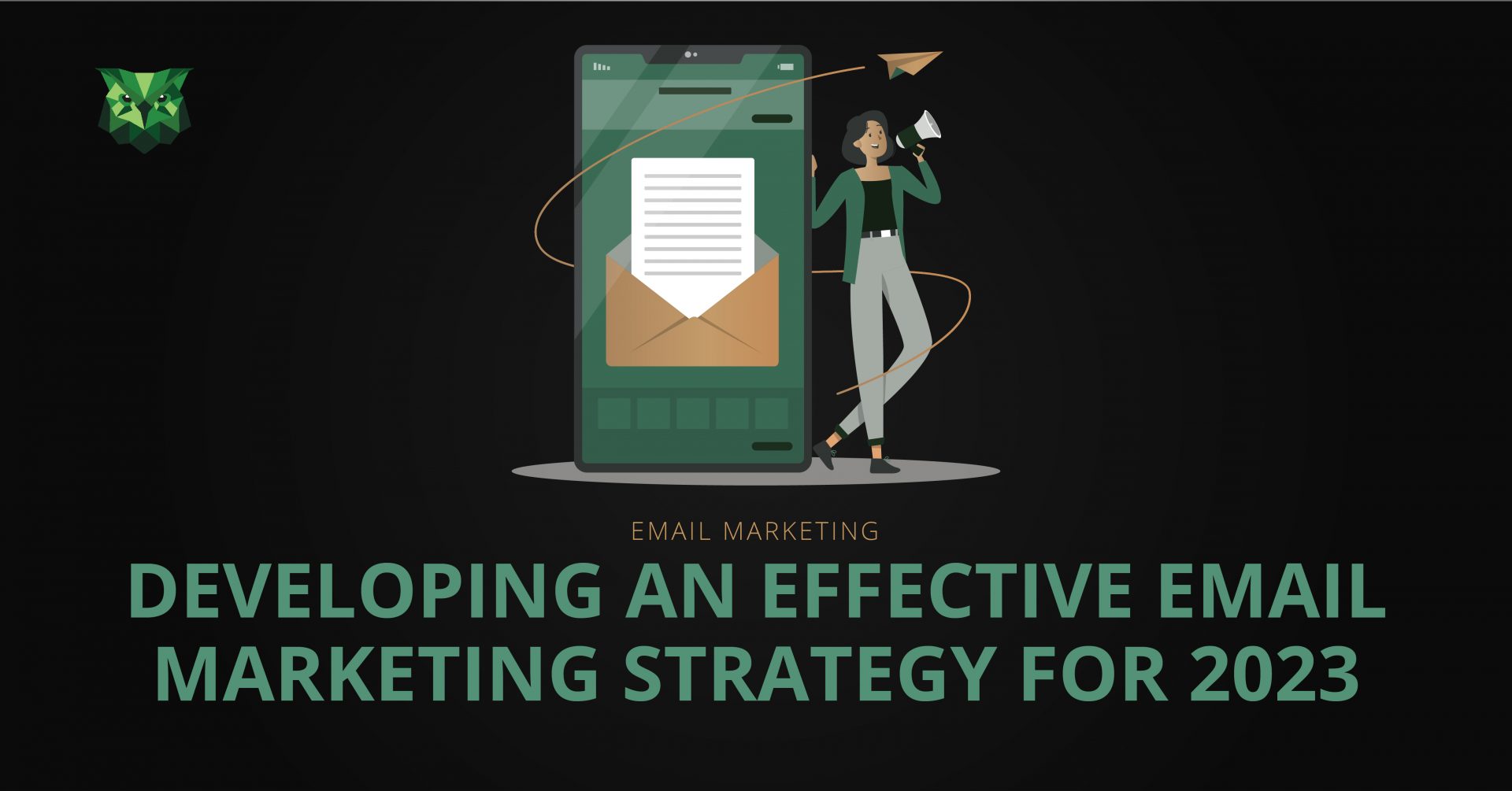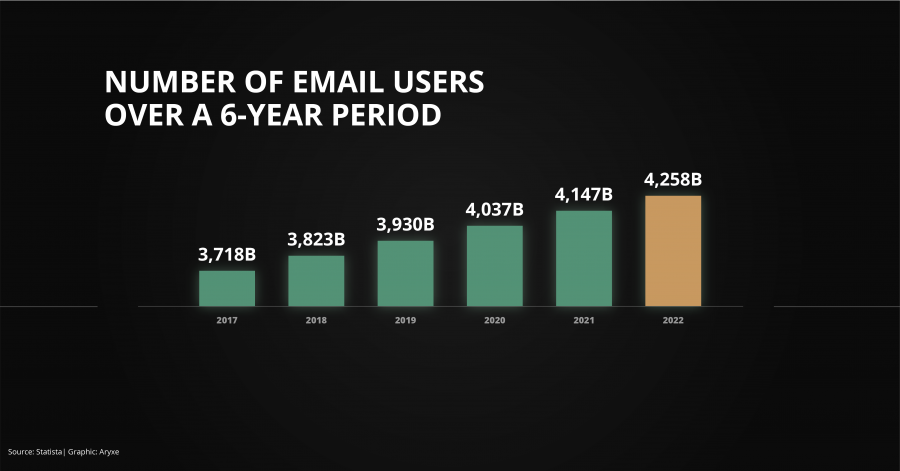Developing an Effective Email Marketing Strategy for 2023
9 min read

9 min read

Have you ever thought about implementing email marketing in your digital strategy, or do you think most people will simply ignore your emails? Consider this: in 2022, there were 4.26 billion e-mail users worldwide, and the revenue of email marketing was expected to reach $8.49 billion by the end of the year.
Still trying to decide if you should do it? Check out this graph to see the email users’ growth over the past six years.

Did you know that 96% of people check their inboxes daily, often up to 20 times per day? This means that if someone has subscribed to your emails, there’s a good chance they will see them. However, if your emails aren’t engaging, they might choose to ignore them. If you want to create an email marketing strategy that will be successful in 2023 and make people open and read your emails, whether to generate sales or increase brand awareness, keep reading for some tips and ideas.
Before you can send out any emails, you’ll need to have a list of subscribers. These can be potential customers or people who have already purchased from you. When people visit a website or online store, they don’t take the next step of making a purchase. Instead, they simply leave the site and may not come back. To avoid losing these potential customers, it’s crucial to have a way to reach out to them and keep your business top-of-mind.
There are several effective ways to implement a call-to-action (CTA) button for subscribing to an email newsletter. One option is to use a pop-up message on your website that allows visitors to enter their email address. You can also include a CTA button in your social media posts and stories, linking people to a landing page where they can sign up for your newsletter. However, it’s important to remember that people are more likely to give their email address if they know they’ll receive something in return. So, be sure to clearly communicate the benefits of subscribing to your newsletter.
One of the most effective ways to gain subscribers for your newsletter is to offer a discount, special offer, or freebie. Everyone loves getting something for free, and although it may not be feasible to give away full-sized products, you can consider offering digital assets as an alternative. For example, if you own an online shop for kitchen utensils, you could offer a digital cookbook with recipes that feature your products as a freebie. This is a win-win situation, as it gives the recipient a valuable resource and introduces them to your products at the same time. Another idea is to offer a personalized discount code for your online shop or services, which can make potential customers feel special and encourage them to make a purchase.
Now that you have a list of subscribers, you can start planning and sending out your newsletters. However, it’s important not to send them too frequently, as this can lead to people unsubscribing due to annoyance. A good rule of thumb is to send newsletters once a month, although you can send them more often if you have important news, updates, or special offers to share. This way, you can keep your subscribers engaged and informed without overwhelming them with too many emails.
Who enjoys reading long, boring texts? Most people don’t, and the same goes for the recipients of your emails. To create a successful marketing strategy, it’s important to provide valuable and exciting content that your subscribers will find helpful. Think about what will keep the reader engaged and make them want to read until the end. It’s also important not to make your emails too long – one or two scrolls should be sufficient.
For example, suppose you own an online shop for kitchen utensils. In that case, you could consider sending your subscribers a monthly email with a seasonal recipe and a step-by-step tutorial with pictures showcasing how to use your products. This type of content aligns with the interests of your potential customers (who are interested in cooking) and provides them with valuable information and inspiration.
One way to encourage repeat visits to your website is to implement an email marketing campaign that sends newsletters to your subscribers. This will remind them of your business and encourage them to return to your site.
Suppose you have collected emails from visitors who have not made a purchase. In that case, you can use technology to track their activity and retarget them with a personalized email offering a discount or other incentive to encourage them to complete their purchase. For example, you could offer a 15% discount to those who come back and make a purchase within the next 24 hours. This type of targeted marketing can be an effective way to encourage conversions and drive repeat business.
To increase the chances that your emails will be opened, it is essential to create catchy and informative subject lines that clearly communicate the content of the email. Personalized subject lines have been shown to increase open rates by 26%, and emojis can boost conversion rates by up to 56% compared to text-only subject lines, according to Campaign Monitor. Keep in mind that subject lines are usually truncated on some devices, so it is vital to keep them concise and to the point. Aim for no more than 9 words and 60 characters. For example, instead of “Hey, there [First Name], open this email, because we have a great deal for you,” which may be truncated, try something shorter and more straightforward like “Hi, [First Name], take -20% off sitewide!” This will grab the recipient’s attention and increase the chances of them opening your email.
If you are unsure which subject line will be more effective for your emails; you can conduct A/B testing by sending the same newsletter to two separate groups of subscribers with different subject lines. This will allow you to determine which subject line generates higher opening rates. Similarly, you can test the click-through rate (CTR) by sending versions with different buttons and button text to different groups of recipients. By analyzing the performance of these different versions, you can determine which elements are most effective at driving engagement and conversions.
It can be frustrating to try to navigate an email on a mobile device, especially if it is not optimized for mobile screens. According to Statista, 36.6% of emails are opened on mobile devices, yet 20% of marketing email campaigns are not optimized for these devices. To ensure that your emails are accessible and user-friendly on mobile devices, it is important to consider factors such as readability, contrast, and the size of buttons when designing the layout of your newsletters. This will help improve mobile users’ overall experience and increase their chances of engaging with your emails.
Maintaining a consistent design for your newsletters is important to help establish your brand identity and make it easier for your subscribers to recognize your emails. This includes using the same colors, fonts, visuals, and brand voice in each email. The design of your newsletter should also be visually appealing and easy to navigate, with a clear hierarchy that allows the reader to easily find the information they are looking for. Consider placing your logo at the beginning of the email and highlighting important messages with prominent call-to-action (CTA) buttons to encourage engagement. By keeping your design consistent and attention-grabbing, you can improve the effectiveness of your email marketing efforts.
When selecting a sender name for your emails, it is important to be as specific and straightforward as possible. This will help the reader understand who the email is from and why they are receiving it. It is also a good idea to include contact information at the bottom of your email template, such as your business name, address, phone number, and email. This can make it easy for subscribers to get in touch with you if they have questions or want to learn more about your business. In addition, by providing precise and accurate contact information, you can increase the chances that your emails will be engaged and build trust with your subscribers.
It is important to always include an unsubscribe button in your emails to allow subscribers to opt-out of receiving future emails if they wish. Most email marketing platforms have an unsubscribe button in their templates, which can be customized with different fonts, sizes, and colors to match your brand. While it is always our hope that subscribers will continue to engage with our emails, it is essential to give them the option to opt out if they no longer want to receive them. This helps to ensure that you are complying with best practices for email marketing and respecting your subscribers’ preferences.
To encourage people to subscribe to your email newsletter, it is important to provide a compelling reason for them to do so. This could include offering valuable, useful information, exclusive offers, and other incentives. You should also optimize your newsletters for mobile devices and personalize them to make them more engaging. Using emojis and eye-catching phrases in the subject line can help to increase the chances that your emails will be opened. Remember that subject lines are often truncated on some devices, so it is important to keep them concise and to the point. Finally, be sure to consistently provide valuable and useful content to show subscribers that subscribing to your newsletter was a good decision.
What You Need to Know to Build an Email Marketing Strategy for 2023 (onestopemails.com)
73+ Email Marketing Statistics 2022 [Trending Facts & Data] (demandsage.com)
How often should you send marketing emails? (smaily.com)
Email Subject Line Tips and Best Practices for 2022 (with Examples!) | Campaign Monitor
Any reuse, transmission, republication, duplication, or distribution of this article and graphics, without the express written permission of Aryxe is not allowed. If you wish to reuse, transmit, republish, duplicate or distribute this article, cite passages, or use in full, including but not limited to proprietary text and graphics, please request written permission.